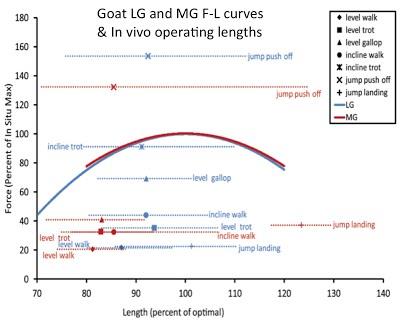Evaluating In vivo Force-Length Behavior in Relation to F-L Muscle Properties
| As part of our effort to improve and validate muscle models, postdoc Maria de Boef Miara (now at Brandeis University), Jennifer Carr and I have examined how the in vivo force-length bahavior of muscles (determined from sonomicrometry and tendon buckle force recordings) relates to the muscle's in situ isometric F-L properties. This work has utilized the goat medial and lateral gastrocnemius muscles (MG & LG). In addition to recording fiber length changes of these muscles, we have also examined how fiber rotation (or changes in muscle pinnation) may affect fiber shortening relative to whole muscle shortening, referred to as 'muscle gearing'. Increases in fiber rotation (increased pinnation) can enhance overall muscle shortening or favor increased force output by reducing the shortening velocity of the muscle's fibers. |  |
 |
 |
| Our results for the goat MG and LG muscles show that these muscles operate at short lengths that correspond to the ascending limb of their F-L relation at low intensity activities (e.g. walking) but operate at longer lengths, closer to or even beyond the optimal length for isometric force generation, during more intense activities (galloping & jumping). As the muscle's shorten, their pinnation increases, and when contracting at longer lengths the muscles operate at lower angles of pinnation, suggesting that changes in pinnation allow the muscles to produce greater force when shortening than they would otherwise. | |
